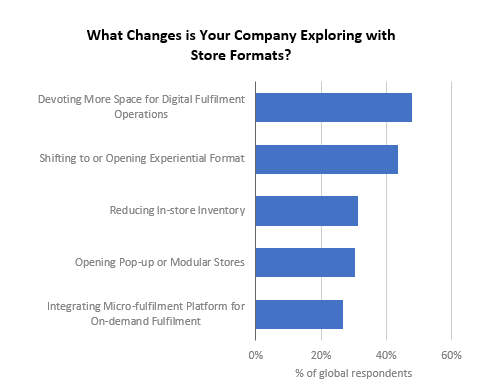In the short term, high inflationary pressures will largely shape consumers’ and manufacturers’ behaviour in food markets worldwide. Consumers will overall spend more cautiously on food; eating out less, shopping more at discounters, and cooking more at home. Food manufacturers will face lingering high raw materials costs and commodity shortages. The longer-term or permanent remote working policies adopted by many organisations will keep many meals at home, with delivery models enabling consumers to easily enjoy fresh food and a restaurant-like experience. Growing sustainability concerns will lead to more substantial and multifaceted investments on this front, particularly when rethinking the supply chain.
Short-term outlook: Inflation remains top-of-mind
In 2023, global consumer price inflation is anticipated to slow to 5.7%, from 9.0% in 2022. Although foodservice is functioning again, the shift to eating at home is expected to persist, as consumers continue to feel the impact of this unusually high inflationary pressure and spend more cautiously on food. Cooking at home remains a good way to curb food spending. This will benefit staple foods and cooking ingredients and meals, particularly food kits, for example the soaring Hello Fresh offering.
E-commerce will attract further consumers. At the same time, in the dominant offline retail environment, discounters and warehouse clubs will be among the biggest winners as shoppers seek more competitive prices and deals.
The supply chain remains in a major transitional phase. Food businesses have been able to overcome some of the supply chain issues encountered early on in the pandemic, but many problems will persist in 2023, particularly amidst prohibitive raw materials costs and commodity shortages due to the war in Ukraine. Sustainability concerns add to the need for major changes in supply chain mechanics.
Mid- to long-term outlook: Technology and sustainability to shape mechanics of food markets
The pandemic-related polarisation of consumer spending is becoming more evident, with trading down, but some trading up, too. Shoppers are likely to be adventurous when it comes to discretionary food expenses such as snacks, as a way to treat themselves, whilst trying to cut back on bigger spending related to fuel usage or outings. Many employers and employees have also embraced hybrid working models, and people who might never have been eating lunch (and/or breakfast) at home across Monday to Friday will be doing so three or more times per week, which should enable food retail volumes to remain strong to 2027.
As delivery models become faster and faster, e-commerce will not only maintain velocity in retail, but also represent a growing revenue stream across the foodservice channel. Quick commerce, whereby an online retail business commits to delivering products quickly, often in under an hour, is transforming the landscape of grocery shopping in India, for instance. Meanwhile, frictionless stores, a concept consisting of removing as many touchpoints as possible in the in-store buying process, and in which German retailer REWE invested in 2022, for example, will be more common and attractive. The online product offering will also continue to widen, enabling consumers to enjoy more home-delivered fresh and chilled items, as well as indulgent foods from foodservice, such as baked goods.

On the operational front, food businesses will place a greater focus on localism. Government policies will help stir investments in this direction, bringing more specific policies on agribusiness and food security. More food manufacturers are expected to adopt regenerative farming and production practices and reach new, economically alienated consumers.
There is still ample room for food companies to futureproof their business by rethinking their operations and logistics into more circular models. Food brand owners and retailers, but also restaurants, cafés and bakeries, could also invest further in at-home eating occasions and delivering a quality at-home food experience, which consumers are likely to aspire to amidst a more complex and uncertain macroenvironment.
